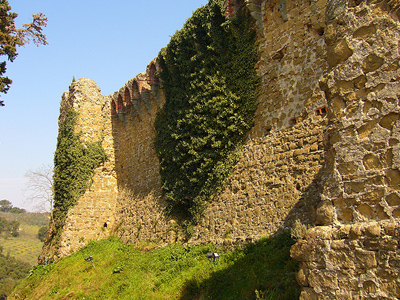
As ancient as time itself, Malmantile stands as a fortified village. A few kilometers down the old Via Pisana from Lastra A Signa leads in the direction of Montelupo Fiorentino. There among the majestic hills, the Medieval Castle of Malmantile beckons with the ancient hands of time. Though not a very big fortification, the castle built in the 15th century is unusual with its strong walls still holding out against the elements of time. Though the origins are mysterious, Malmantile was a military stronghold on the old road that connected Florence with Pisa before it evolved into a town. An interesting fact accompanies the name ‘Mamantile’. As the legends traverse back to the 4th century, S. Ambrogio, the bishop of Milan was travelling to central Italy and en route met S. Zanobi, the bishop of Florence. The bishops were put up at a homestead there. When S.Ambrogio left, he was so upset at the bad treatment he received there and cursed the place. A few days later, the homestead crashed and fell to the ground. After this strange event, the place was named ‘Malmantile’ which in ancient Italian meant ‘bad welcome’.
The Gothic walled enclosure dates back to 1424 and was one of the first of its kind to be built. As a fortified town wall, it was a classic example with machicolations along the perimeter, the style of which was used through the following years. As another accolade, the famous architect, Brunelleschi was involved in its construction. Forming a perfect rectangle, the walls have a dimension of 125×70 meters with 2 gates. Though the walls still stand, there is little remaining of the machicoulis. Formed by brackets in stone, four rounded projections were built with bricks to support the ogival arch made of “beccatelli” or gray stone. On the alternate arches there were holes or protrusions with square embrasures, from where, during an attack, defenders dropped heavy objects or boiling liquids on the enemies who climbed up the wall. The whole boundary wall had slits at ten meter intervals to permit a man armed with bow and arrows to look through and aim at the enemy.
The town-walls have square towers at its angles and two towers at the middle of the longest sides. The two gates have curved arches structured on the outside of the town wall with loopholes on both sides. Part of the wall facing Pisa on the southwest still retains the machicolation with a parapet. At the south of the gate, the walls are pierced by the windows of the houses built on the inside. The northwest side is open but almost covered by the houses built on the outside. The gate that leads to Florence is in dire need of renovation. The walls were very important as the Florentine Republic found it necessary to control the road leading to the enemy boundary of Pisa. But the construction of the walls took time and was finished only after Pisa was conquered. The fortified strategic point of the road to Pisa lost its importance after the fall of the Florentine Republic in 1530. As a result of which Malmantile remained an isolated post and was not touched by modernity.
Today, Malmantile is quiet and tranquil with few or no tourists. This ancient town houses a few shops, a school, a pharmacy and a post office. There is a lovely 16th century cantina there that serves traditional fare such as, game dishes among which you can find Sweet and Sour Hare/Rabbit. You can also find a delicious and filling ‘panino con salame e stracchino’ or a bread roll with salami and rich cheese and plenty of Chianti Colle Bertini made at the Fattoria. Malmantile between the months of May and June re-enacts the ‘Festa Medievale‘ or a medieval festival or joust.
